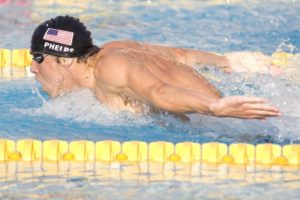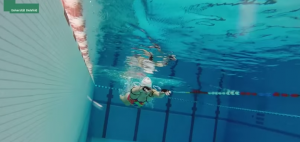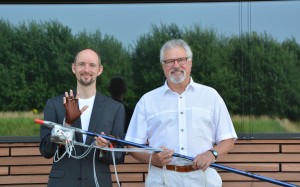With the Olympics in full swing we wanted to share an article we came across on HearingReview.com about how sound data and hearing can actually help swimmers enhance performance. This is just an interesting research article, maybe someday we will know more about how this type of system could work for people with hearing impairment and hearing aid technology. Check out the article below..
 It’s hard to imagine champion swimmer Michael Phelps improving upon the gold-medal swimming techniques he has demonstrated at the Olympics but, according to researchers in Germany, they have created a new sound system that could make Phelps, and other professional swimmers, even faster in the water.
It’s hard to imagine champion swimmer Michael Phelps improving upon the gold-medal swimming techniques he has demonstrated at the Olympics but, according to researchers in Germany, they have created a new sound system that could make Phelps, and other professional swimmers, even faster in the water.
Researchers at the Cluster of Excellence Cognitive Interaction Technology (CITEC) of Bielefeld University announced that they have developed a “Swimming Sonification” system that professional swimmers can use to optimize their swimming technique. The system reportedly expands the athlete’s perception and feel for the water by enabling him to hear, in real time, how the pressure of the water flows over his body, helping him change his movements to improve performance, giving the swimmer an advantage over his competitors because he can refine the execution of his technique.
In a YouTube video, Bielefeld University’s “research_tv” program reports on the new system, first explaining that all swimmers can see the movements of their hands and also feel how the water glides over their hands, helping them sense how quickly they are moving forwards. But, swimmers who train using sonification, would have more information on their speed and agility in the water.

A swimmer tests the Swimming Sonification system that was developed in Germany to help swimmers enhance their technique for competition. Photo: CITEC/Bielefeld University
“The majority of swimmers are not very aware of one significant factor: how the pressure exerted by the flow of the water on their bodies changes,” said Thomas Hermann, PhD, of the CITEC. The sound researcher is working on converting data into sounds that can be used to benefit the listener. This is called sonification, a process in which measured data values are systematically turned into audible sounds and noises. “In this project, we are using the pressure from water flows as the data source,” said Hermann, who heads the CITEC research group Ambient Intelligence. “We convert into sound how the pressure of water flow changes while swimming – in real time. We play the sounds to the swimmers over headphones so they can then adjust their movements based on what they hear.”
For this research project on swimming sonification, Hermann is working with Bodo Ungerechts, PhD, of the Faculty of Psychology and Sports Science. As a biomechanist, Ungerechts deals with how human beings control their movements, particularly while swimming.
“If a swimmer registers how the flow pressure changes by hearing [the sound of it], he can better judge, for instance, how he can produce more thrust at similar energy costs,” said Ungerechts. “This gives the swimmer a [broader] perception of his movements in the water.”
Ungerechts tested the Swimming Sonification system on himself. “I was surprised at just how well the sonification and the effects of the water flow corresponded with one another,” he reported, adding that the system is intuitive and easy to use. “You immediately start playing with the sounds to hear, for example, what tonal effect spreading your fingers apart or changing the position of your hand has. The system should open up new training possibilities for athletes.”

Researchers Thomas Hermann (left) and Bodo Ungerechts (right) have developed a system with Daniel Cesarini that uses sound to expand a swimmer’s perception and feel for the water. Photo: CITEC/Bielefeld University
Ungerechts says that with this system, swimmers can develop a harmony or sound melody of their best techniques. For example, if a swimmer masters a lap at high speed, they can use the recording of the melody to mentally re-imagine and retrace the successful execution of this lap. This type of mental training could possibly help athletes perform successfully in competition. In a practical workshop held in September 2015, professional swimmers tested the system out and confirmed that it helped them to optimize their swimming technique.
“The ear is great at perceiving rhythm and changes in rhythm, and in this way, swimmers can find their own rhythm and use this to orient themselves in the water,” said Thomas Hermann.
The Swimming Sonification system includes two gloves with thin tube ends that serve as pressure sensors and are fixed between the fingers. The swimmer wears these gloves during practice. The tubes are linked to a measuring instrument, which is connected to the swimmer via a line while he or she is swimming. The measuring device transmits data about water flow pressure to a laptop. A custom-made software program then sonifies the data, turning the information into sound. “During repeated hand actions, for instance, the system can make rising and sinking flow pressure audible as increasing or decreasing tonal pitches,” said Hermann. Other settings that sonify features such as symmetry or steadiness can also be activated as needed.
The sounds are transmitted to the swimmer in real time over headphones. When the swimmer modifies a movement, he hears live how this also changes the sound. With the sonification of aquatic flow pressure, the swimmer can practice performing different swim strokes in different ways and make adjustments. Because the coach also hears the sounds over speakers, he can base the instructions he gives to the swimmer not only on the movements he observes, but also on the sounds generated by the swimmer and their rhythm (eg, “Move your hands so that the tonal pitch increases faster”).
Hermann and Ungerechts are collaborating with Daniel Cesarini, PhD, a researcher in the Department of Information Engineering at the University of Pisa in Italy, who developed the measuring device that analyzes the aquatic flow pressure data.
The researchers want to continue developing their current prototype, and are planning to develop a wearable system that can be used independently by the swimmer, without the help of others. The new sonification method is planned to be incorporated into long-term training programs in cooperation with swim clubs.
Source: Cluster of Excellence Cognitive Interaction Technology (CITEC) of Bielefeld University; “research_tv”
Image credits: CITEC/Bielefeld University; © Mitchell Gunn | Dreamstime.com
